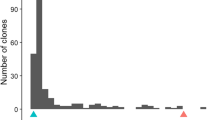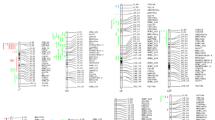Abstract
Chromosome substitution (CS) lines in plants are a powerful genetic resource for analyzing the contribution of chromosome segments to phenotypic variance. In this study, a series of interspecific cotton (Gossypium spp.) CS lines were used to identify a new germplasm resource, and to validate chromosomal regions and favorable alleles associated with nematode or fungal disease resistance traits. The CS lines were developed in the G. hirsutum L. TM-1 background with chromosome or chromosome segment substitutions from G. barbadense L. Pima 3–79 or G. tomentosum. Root-knot nematode (Meloidogyne incognita) and fusarium wilt (Fusarium oxysporum f. sp. vasinfectum) (races 1 and 4) resistance alleles and quantitative trait loci (QTL) previously placed on cotton chromosomes using SSR markers in two interspecific recombinant inbred line populations were chosen for testing. Phenotypic responses of increased resistance or susceptibility in controlled inoculation and infested field assays confirmed the resistance QTLs, based on substitution with the positive or negative allele for resistance. Lines CS-B22Lo, CS-B04, and CS-B18 showed high resistance to nematode root-galling, confirming QTLs on chromosomes 4 and 22 (long arm) with resistance alleles from Pima 3–79. Line CS-B16 had less fusarium race 1-induced vascular root staining and higher percent survival than the TM-1 parent, confirming a major resistance QTL on chromosome 16. Lines CS-B(17–11) and CS-B17 had high fusarium race 4 vascular symptoms and low survival due to susceptible alleles introgressed from Pima 3–79, confirming the localization on chromosome 17 of an identified QTL with resistance alleles from TM1 and other resistant lines. Analyses validated regions on chromosomes 11, 16, and 17 harboring nematode and fusarium wilt resistance genes and demonstrated the value of CS lines as both a germplasm resource for breeding programs and as a powerful genetic analysis tool for determining QTL effects for disease resistance. CS lines carrying small alien chromosome segments with favorable QTL alleles could be used for effective introgression of biotic stress resistance or many other desirable traits by targeting gene interactions and reducing linkage drag effects.



Similar content being viewed by others
References
Armstrong GM, Armstrong JK (1960) American, Egyptian, and Indian cotton-wilt Fusaria: Their pathogenicity and relationship to other wilt fusaria. U.S. Dep. Agric. Tech, Bull 219
Baker KF (1957) The U.C. system for producing healthy container-grown plants. Calif Agric Exp Stn Man 23:1–332
Blasingame D, Patel MV (2004) Cotton disease loss estimate committee report. Proc Beltwide Cotton Conf 1:459–460
Bolek Y, Bell AA, El-Zik KM, Thaxton PM, Magill CW (2005) Reaction of cotton cultivars and an F2 population to stem inoculation with isolates of Verticillium dahliae. J Phytopathol 153:269–273
Campbell BT, Baenziger PS, Gill KS, Eskridge KM, Budak H, Erayman M, Dweikat I, Yen Y (2003) Identification of QTLs and environmental interactions associated with agronomic traits on chromosome 3A of wheat. Crop Sci 43:1493–1505. doi:10.2135/cropsci2003.1493
Chaudhary B, Flagel L, Stupar RM, Udall JA, Verma N, Springe NM et al (2009) Reciprocal silencing, transcriptional bias and functional divergence of homeologs in polyploid cotton (Gossypium). Genetics 182:503–517
Dighe N, Robinson AF, Bell A, Menz M, Cantrell R, Stelly D (2009) Linkage mapping of resistance to reniform nematode in cotton (Gossypium hirsutum L.) following introgression from G. longicalyx (Hutch & Lee). Crop Sci 49:1151–1164
Egamberdiev SS, Ulloa M, Saha S, Salakhudinov IB, Abdullaev A, Glukhova LA, Adylova AT, Scheffler BE, Jenkins JN, Abdurakhmonov IY (2013) Molecular characterization of Uzbekistan isolates of Fusarium oxysporum f. sp. vasinfectum. J Plant Sci Mol Breed 2:3
Gutierrez OA, Jenkins JN, McCarty JC, Wubben MJ, Hayes RW et al (2010) SSR markers closely associated with genes for resistance to root-knot nematode on chromosomes 11 and 14 of Upland cotton. Theor Appl Genet 121:1323–1337
Hussey RS, Barker KR (1973) A comparison of methods of collecting inocula of Meloidogyne spp. including a new technique. Plant Dis Rep 57:1025–1028
Hyer AH, Jorgenson EC, Garber RH, Smith S (1979) Resistance to root-knot nematode in control of root-knot nematode Fusarium wilt disease complex in cotton Gossypium hirsutum. Crop Sci 19:898–901
Jenkins JN, McCarty JC Jr, Wu J, Hayes R, Stelly D (2012) Genetic effects of nine Gossypium barbadense L. chromosome substitution lines in top crosses with five elite Upland cotton G. hirsutum L. cultivars. Euphytica 187:161–173
Kim Y, Hutmacher RB, Davis RM (2005) Characterization of California Isolates of Fusarium oxysporum f. sp. vasinfectum. Plant Dis 89:366–372
Kochman J, Swan L, Moore N, Bentley S, O’Neill W, Mitchell A, Obst N, Lehane J, Gulino L, Salmond G (2002) The Fusarium threat-are we making the progress? Proceeding of 11th cotton conference, Brisbane, Australia, pp 643–652, 13–15 August 2002
Niu C, Lister HE, Nguyen B, Wheeler TA, Wright RJ (2008) Resistance to Thielaviopsis basicola in the cultivated A genome cotton. Theor Appl Genet 117:1313–1323
Roberts PA, Ulloa M, Wang C (2007) Host plant resistance to root-knot nematode in cotton. Proc Fourth World Cotton Res Conf, Lubbock, TX
Saha S, Stelly DM, Raska DA, Wu J, Jenkins JN, McCarty JC, Makamov A, Gotmare V, Abdurakhmonov IY, Campbell BT (2011) Chromosome substitution lines: concept, development and utilization in the genetic improvement of Upland cotton. In: Abdurakhmonov IY (ed). Plant breeding: Rijeka Croatia: InTech, Slavka Krautzeka 83/A, Open Access Publisher, 107–128
Saha S, Wu J, Jenkins JN, McCarty JC, Stelly DM (2013) Interspecific chromosomal effects on agronomic traits in Gossypium hirsutum by AD analysis using intermated G. barbadense chromosome substitution lines. Theor Appl Genet 126:109–117
Saha S, Stelly DM, Makamov AK, Ayubov MS, Raska D, Gutierrez OA, Manchali S, Jenkins JN, Deng D, Abdurakhmonov IY (2015) Molecular confirmation of Gossypium hirsutum chromosome substitution lines. Euphytica. doi:10.1007/s10681-015-1407-2
Shen X, Van Becelaere G, Kumar P, Davis RF, May LO et al (2006) QTL mapping for resistance to root-knot nematodes in the M-120 RNR Upland cotton line (Gossypium hirsutum L.) of the Auburn 623 RNR source. Theor Appl Genet 113:1539–1549
Shepherd RL (1974) Transgressive segregation for root-knot nematode resistance in cotton. Crop Sci 14:872–875
Skovgaard K, Nirenberg HI, O’Donnell K, Rosendahl S (2001) Evolution of Fusarium oxysporum f. sp vasinfectum races inferred from multigene genealogies. Phytopathology 91:1231–1237
Smith AL, Dick JB (1960) Inheritance of resistance to Fusarium wilt in Upland and Sea Island cotton as complicated by nematodes under field conditions. Phytopathology 50:44–48
Smith SN, Ebbels DL, Garber RH, Kappelman AJ (1981) Fusarium wilt of cotton. In: Nelson PE, Toussoun TA, Cook RJ (eds) Fusarium: diseases, biology, and taxonomy. Pennsylvania State University, University Park, pp 29–38
Snape JW, Law CN, Young CF, Worland AJ (1979) Genetical analysis of chromosome substitution lines of bread wheat using second generation hybrids. Heredity 34:297–303
Stelly DM, Saha S, Raska DA, Jenkins JN, McCarty JC, Gutierrez OA (2005) Registration of 17 Upland (Gossypium hirsutum) germplasm lines disomic for different G. barbadense chromosome or arm substitutions. Crop Sci 45:2663–2665
Ulloa M, Hutmacher RB, Davis RM, Wright SD, Percy R, Marsh B (2006) Breeding for Fusarium wilt Race 4 resistance in cotton under field and greenhouse conditions. J Cotton Sci 10:114–127
Ulloa M, Brubaker C, Chee P (2007) Cotton. In: Kole C (ed) Genome mapping and molecular breeding Vol. 6: technical crops. Springer, Berlin
Ulloa M, Wang C, Roberts PA (2010) Gene action analysis by inheritance and quantitative trait loci mapping of resistance to root-knot nematodes in cotton. Plant Breed 129:541–550
Ulloa M, Wang C, Hutmacher RB, Wright SD, Davis RM, Saski CA, Roberts PA (2011) Mapping Fusarium wilt race 1 genes in cotton by inheritance, QTL and sequencing composition. Mol Genet Genomics 286:21–36
Ulloa M, Hutmacher RB, Roberts PA, Wright SD, Nichols RL, Michael DR (2013) Inheritance and QTL mapping of Fusarium wilt race 4 resistance in cotton. Theor Appl Genet 126:1405–1418
Wang C, Roberts PA (2006) A Fusarium wilt resistance gene in Gossypium barbadense and its effect on root-knot nematode-wilt disease complex. Phytopathology 96:727–734
Wang C, Ulloa M, Roberts PA (2006) Identification and mapping of microsatellite markers linked to a root-knot nematode resistance gene (rkn1) in Acala NemX cotton (Gossypium hirsutum L.). Theor Appl Genet 112:770–777
Wang P, Su L, Qin L, Hu B, Guo W, Zhang T (2009) Identification and molecular mapping of Fusarium wilt resistant gene in upland cotton. Theor Appl Genet 119:733–739
Wang C, Ulloa M, Mullens TR, Yu JZ, Roberts PA (2012) QTL analysis for transgressive resistance to root-knot nematode in interspecific cotton (Gossypium spp.) progeny derived from susceptible parents. PLoS ONE 7:e34874. doi:10.1371/journal.pone.0034874
Wang C, Ulloa M, Roberts PA (2014) A major locus for fusarium wilt race 4 resistance identified in Gossypium h irsutum Acala NemX using an interspecific progeny with G barbadense [abstract]. National Cotton Council Beltwide Cotton Conference, January 6–8, 2014, New Orleans, Lousiana. No. 15614. http://www.ars.usda.gov/research/publications/publications.htm?SEQ_NO_115=300161
Wendel JF, Cronn RC (2003) Polyploidy and the evolutionary history of cotton. Adv Agron 78:139–186
Ynturi P, Jenkins JN, McCarty JC Jr, Gutierrez OA, Saha S (2006) Association of root-knot nematode resistance genes with simple sequence repeat markers on two chromosomes in cotton. Crop Sci 46:2670–2674
Yu J, Kohel RJ, Fang DD, Cho J, Van Deynze A, Ulloa M, Hoffman SM, Pepper AE, Stelly DM, Jenkins JN, Saha S, Kumpatla SP, Shah MR, Hugie WV, Percy RG (2012) A high-density simple sequence repeat and single nucleotide polymorphism genetic map of the tetraploid cotton genome. Genes Genomes Genetics 2:43–58
Acknowledgments
This study was funded by USDA-ARS (Project 6208-21000-019-00) (MU and JB) and partially funded by a Reimbursable Agreement with Cotton Incorporated (CA State Support Committee), Cary, NC (ARIS Log Nos. 5303-05-00 0029833) (MU), a Cooperative Research Agreement with Cotton Incorporated and a University of California Discovery Grant (PAR). The authors would like to thank M. Mirzakhmedov and A. Tulanov visiting students from Uzbekistan working at the USDA-ARS, Lubbock, TX for assisting in running some of the SSR markers. Mention of trade names or commercial products in this article is solely for the purpose of providing specific information and does not imply recommendation or endorsement by the U. S. Department of Agriculture or University of California. The U. S. Department of Agriculture and University of California are equal opportunity providers and employers.
Author information
Authors and Affiliations
Corresponding authors
Electronic supplementary material
Below is the link to the electronic supplementary material.
Rights and permissions
About this article
Cite this article
Ulloa, M., Wang, C., Saha, S. et al. Analysis of root-knot nematode and fusarium wilt disease resistance in cotton (Gossypium spp.) using chromosome substitution lines from two alien species. Genetica 144, 167–179 (2016). https://doi.org/10.1007/s10709-016-9887-0
Received:
Accepted:
Published:
Issue Date:
DOI: https://doi.org/10.1007/s10709-016-9887-0




